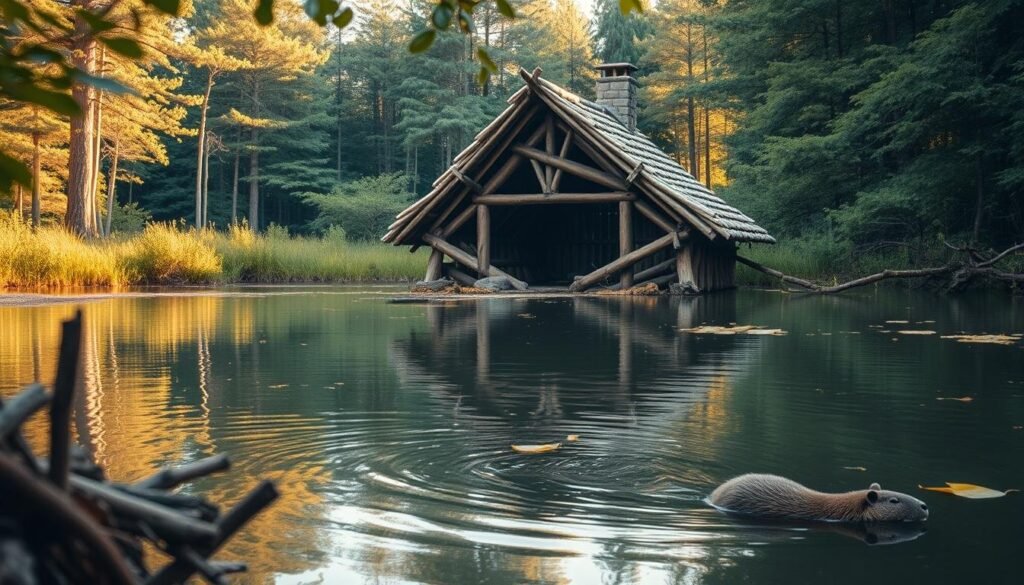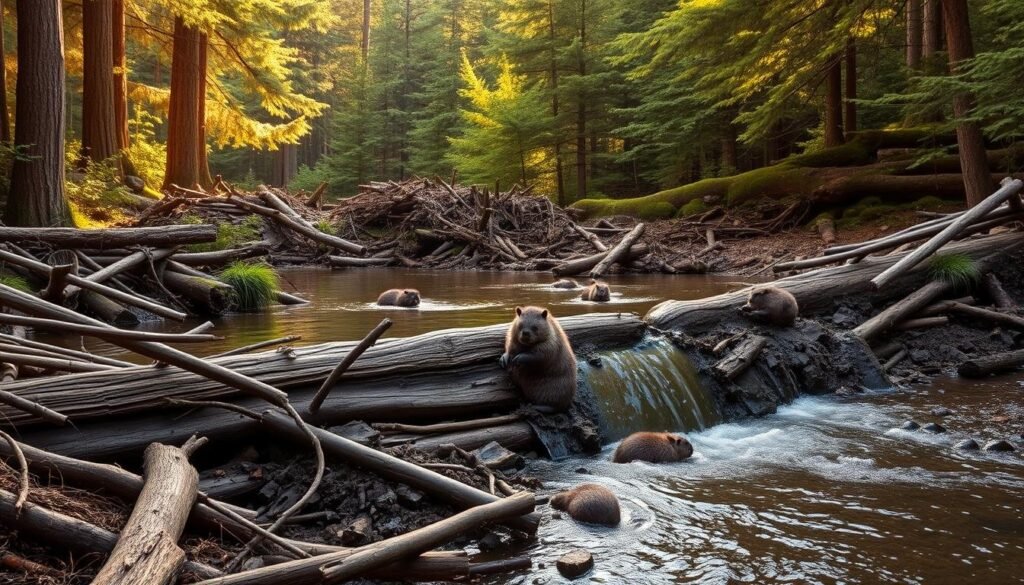Why Do Beavers Build Dams in Streams? Have you ever wondered about the amazing engineering skills of beavers in their natural homes? Beavers are big, semi-aquatic rodents. They are known for building complex dams and lodges.
Their beaver behavior shows how adaptable and important they are in their ecosystems. As you learn more about beavers, you’ll see that building dams is not just instinct. It’s a skill they’ve developed over time.
Learning about beaver behavior helps us understand their role in changing their environments. They create homes for other animals too.
Contents
- 1 The Natural Engineers of North American Waterways
- 2 Why Do Beavers Build Dams in Streams?
- 3 The Architecture and Construction of Beaver Dams
- 4 Beaver Lodges: The Purpose Behind the Pond
- 5 Ecological Benefits of Beaver Dams
- 6 Human Interactions with Beaver Engineering
- 7 Conclusion: Why Do Beavers Build Dams in Streams?
- 8 FAQ
- 8.1 Why do beavers build dams in streams?
- 8.2 What materials do beavers use to construct their dams?
- 8.3 How do beaver dams affect the ecosystem?
- 8.4 Can beaver dams conflict with human activities?
- 8.5 What is the purpose of beaver lodges?
- 8.6 How do beavers adapt to changing environments?
- 8.7 What role do beavers play in shaping their ecosystems?
The Natural Engineers of North American Waterways
Exploring North America’s waterways reveals the amazing work of beavers. They are known as “ecosystem engineers.” Their skill in building dams shows their incredible adaptability and talent.
Beavers have special features that help them in their role. They have specialized teeth and jaws, and webbed feet and powerful tails.
Specialized Teeth and Jaws
Beavers have large, orange-colored incisors for gnawing wood. These teeth are very strong. They use them to cut down trees and branches for their dams.
Their jaws are also adapted for working with wood and other materials. This lets them build their dams with precision.
Beavers’ webbed hind feet make them great swimmers. They can move easily in the water. Their broad, flat tails act as a rudder, helping them stay stable while swimming.
These tails also help when they stand on their hind legs. They give extra support while working on their dams.
Beavers’ physical traits allow them to build complex dams. These dams can change the flow of entire waterways. They also build intricate lodges in their ponds. This shows their amazing ability as wildlife engineers.
Understanding beavers’ physical attributes helps us see their importance. They play a key role in shaping North America’s ecosystems.
Why Do Beavers Build Dams in Streams?
Beavers build dams to make their surroundings safer and more controlled. This is key for their survival. They create a stable home environment.
Creating Water Barriers
Beavers build dams mainly to create water barriers. These barriers keep their lodges safe from predators. They also keep the water level constant, which is vital for their habitat.
The still water lets beavers build their homes safely. They don’t have to worry about sudden water level changes.
Beaver dams also help beavers have underwater escape routes. They build dams to create deep pools of water. This way, they can dive underwater to escape predators.
This shows how beavers are skilled at engineering their environment for safety. Their dams are crucial for their survival. They not only secure their homes but also help balance their ecosystems.
The Architecture and Construction of Beaver Dams
Beaver dams are more than just simple structures. They are marvels of engineering built by beavers. These dams are key to stream ecosystems. Beavers use branches, mud, and plants to create them.
Beavers start with a base of big logs and branches. This base is essential for the dam’s stability. Then, they add smaller sticks, mud, and plants to build it up.
Building a beaver dam changes the stream’s ecosystem. It also creates a home for many other animals. As beavers fix their dams, they help many species thrive.
Key Components of Beaver Dams
- Base layer of larger logs and branches
- Layers of smaller sticks, mud, and vegetation
- Pond-like structure that alters stream flow
Learning about beaver dams shows their big impact on stream ecosystems. These dams prove beavers are skilled engineers. They play a big role in shaping their surroundings.
Beaver Lodges: The Purpose Behind the Pond
Beavers build lodges in their ponds, which are key for their survival and raising young. These lodges are made from sticks, mud, and plants. They offer a safe and cozy home for beavers.

The lodge is vital for raising kits. Its thick walls and underwater entrances protect them from predators and bad weather. This safe haven allows kits to grow and develop without significant threats, ensuring the continuation of the beaver family.
Beaver kits are born after about 100 days of gestation. They spend their early months in the lodge. The lodge’s soft interior is perfect for nursing and growing. As they get older, they start to learn survival skills from their parents.
Seasonal Activities and Behaviors
Beavers have different activities based on the season. In spring, they fix their dams and lodges for the next year. In summer, they gather food and store it for winter.
As autumn comes, beavers prepare for winter by collecting branches and plants. The lodge is a shelter from cold and predators in winter. All year, beavers work on their lodges and dams to keep their beaver habitats safe and working.
Ecological Benefits of Beaver Dams
Beaver dams have many ecological benefits. They create ponds that support a wide range of life, including fish, amphibians, and birds. These ponds are homes for many species, some of which depend on the beaver’s wetlands to survive.
Beaver dams help fish populations. The ponds they make are safe for fish to spawn and grow. For example, trout like the still water, which is warmer than the stream. But, the impact on fish varies by species and dam type.
- Beaver ponds are nurseries for fish, offering food and shelter.
- The still water helps plants grow, supporting more aquatic life.
Amphibian and Bird Habitat
Wetlands from beaver dams are key for amphibians and birds. Amphibians like frogs and salamanders need the ponds for breeding and growing. Birds, including waterfowl and songbirds, use these wetlands for nesting, feeding, and migration stops.
The variety of plants around beaver ponds also supports many bird species. The complex vegetation provides nesting sites and protection from predators.
- The ponds support many plant species, attracting diverse bird life.
- Beaver-created wetlands are vital for migratory birds, offering rest and refueling spots.
In summary, beaver dams have many ecological benefits. They support a rich biodiversity of fish, amphibians, and birds. By creating complex wetland ecosystems, beavers play a crucial role in shaping their environments for the benefit of many other species.
Human Interactions with Beaver Engineering
Beaver dams can affect human activities like forestry, agriculture, and urban planning. They change water flow and can cause flooding. This might seem like a problem.
To solve these issues, we’ve come up with some solutions. One good method is using flow devices. These devices help control water levels behind beaver dams.
Flow Devices and Dam Management
Flow devices are special structures that let water flow out of beaver ponds. They help manage water levels. This stops flooding and keeps the good things beaver dams do for nature.
Here’s a list of common flow devices used in managing dams:
| Type of Flow Device | Description | Benefits |
|---|---|---|
| Notch Devices | Simple structures that create a controlled outlet in the dam | Easy to install, effective for small dams |
| Pond Levelers | Devices that allow water to flow out of the pond at a set level | Maintains a consistent water level, reducing flood risk |
| Beaver Deceivers | Complex systems that manage water flow and reduce dam maintenance | Highly effective for large beaver populations, minimizes human intervention |
Educational Outreach Programs
It’s important to teach people about living with beavers. By learning about beavers and their dams, we can all appreciate them more. This helps us see the good they do for nature.
There are many ways to learn about beavers. Workshops, tours, and educational materials can teach us. They show how beavers help create wetlands and increase biodiversity.
By learning how to manage beaver dams, we can reduce problems. This way, humans and beavers can live together in harmony.
Conclusion: Why Do Beavers Build Dams in Streams?
Beavers are key players in North American waterways. Their amazing engineering skills help them build safe homes. These homes also support many plants and animals.
Beavers are vital for healthy waterways. By learning about and protecting them, we help our environment. Their homes and the ecosystems around them show why we must conserve these waterways.
See Also: Discover Why Giraffes Lick Their Own Bodies
FAQ
Why do beavers build dams in streams?
Beavers build dams to make a safe home. They protect their lodges from predators. They also keep the water level constant.
What materials do beavers use to construct their dams?
Beavers use branches, mud, and plants to build dams. They start with big logs and branches. Then, they add smaller sticks and mud.
How do beaver dams affect the ecosystem?
Beaver dams help many species, like fish and birds. They create homes for many animals. This helps keep the ecosystem balanced.
Can beaver dams conflict with human activities?
Yes, dams can cause problems for humans. They can flood areas used for farming or logging. But, devices can help control the water.
What is the purpose of beaver lodges?
Beaver lodges are cozy homes for beavers. They keep young beavers safe from predators. They also protect against bad weather.
How do beavers adapt to changing environments?
Beavers change their ways with the seasons. Their homes are built to handle different weather. This helps them survive.
What role do beavers play in shaping their ecosystems?
Beavers are key to their ecosystems. Their dams make wetlands. These support many species and keep the ecosystem balanced.

Zyair Larson, based in Denver, Colorado, has over 12 years of experience studying animal behavior. He has worked with the World Wildlife Fund (WWF) and National Geographic, researching wildlife and sharing insights on animal habits globally.

